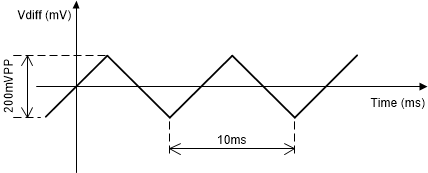SBOA426 March 2021 INA233
4 Measurement Results and Trade-Offs
Measurements were performed with a 100Hz, ± 100mV triangle wave (Figure 4-1) applied to all four INA233 devices. The Group Command is issued to trigger a synchronized one-shot ADC conversion with no averaging. Each INA233 reports back its conversion result in subsequent separate READ transactions. Therefore each time such a conversion-read loop is executed, we get a set of data consisting of four measurements, one from each INA233. This process is repeated several hundred times for each conversion time setting while the AC input is free running. Because the INA233 shunt voltage input range is ± 81.92mV, in a set of measurements, if any one or more are outside of INA233 input range, the set is discarded and not included in the statistics. Within each set of four measurements, the mismatch is defined and calculated as the difference between the largest and smallest measurements. When all mismatch data for a conversion time setting are aggregated, the min, max, standard deviation and average can be calculated.
 Figure 4-1 Differential Input
Signal
Figure 4-1 Differential Input
Signal| Measurement mismatch(uV) vs. Conversion(single, no averaging) time | ||||||||
|---|---|---|---|---|---|---|---|---|
| 140us | 280us | 322us | 588us | 1.1ms | 2.116ms | 4.156ms | 8.224ms | |
| Min | 8 | 13 | 25 | 73 | 198 | 20 | 10 | 5 |
| Max | 130 | 132 | 163 | 218 | 350 | 605 | 1128 | 1575 |
| Stdev | 30 | 26 | 31 | 35 | 36 | 149 | 338 | 455 |
| Mean | 66 | 71 | 87 | 145 | 274 | 451 | 735 | 823 |
INA233 offers programmable averaging modes as well as programmable conversion times. These features allow the device to be configured to optimize the available timing and precision requirements in a given application. Averaging is similar in effect to a longer conversion time. Therefore we can predict that for the same conversion time, as the number of averages increases, the measurement mismatch should get worse. To verify this, we selected a conversion time equal to 140us and compared averaging of 16x and 128x. The relationship between measurement mismatch and averaging is presented in Table 4-2. As predicted, measurement mismatch increases with larger averaging periods.
| Measurement mismatch(uV) vs. number of averaging (140us conversion) | ||
|---|---|---|
| 16X | 128X | |
| Min | 8 | 15 |
| Max | 75 | 1278 |
| Stdev | 164 | 391 |
| Mean | 449 | 772 |
In many applications, the load current to be measured results in a shunt voltage range which is much smaller than the input full-scale range of the device. To visualize how the INA233 performs in synchronized measurement of an AC input with low amplitude, we repeated the same tests with a 100Hz, ±2.5mV triangle wave. This input is also representative of a DC input superimposed with a low amplitude AC component. The relationship between measurement mismatch and conversion time is presented in Table 4-3. A lower amplitude input signal yields smaller mismatch, and thus longer conversion times can be used without a significant increase in mismatch as was seen for the ±100mV case.
| Measurement mismatch(uV) vs. Conversion(single, no averaging) time | ||||||||
|---|---|---|---|---|---|---|---|---|
| 140us | 280us | 322us | 588us | 1.1ms | 2.116ms | 4.156ms | 8.224ms | |
| Min | 5 | 3 | 5 | 3 | 0 | 5 | 5 | 5 |
| Max | 65 | 55 | 40 | 28 | 33 | 33 | 43 | 50 |
| Stdev | 10 | 9 | 6 | 4 | 5 | 8 | 11 | 13 |
| Mean | 31 | 30 | 18 | 16 | 15 | 17 | 21 | 23 |